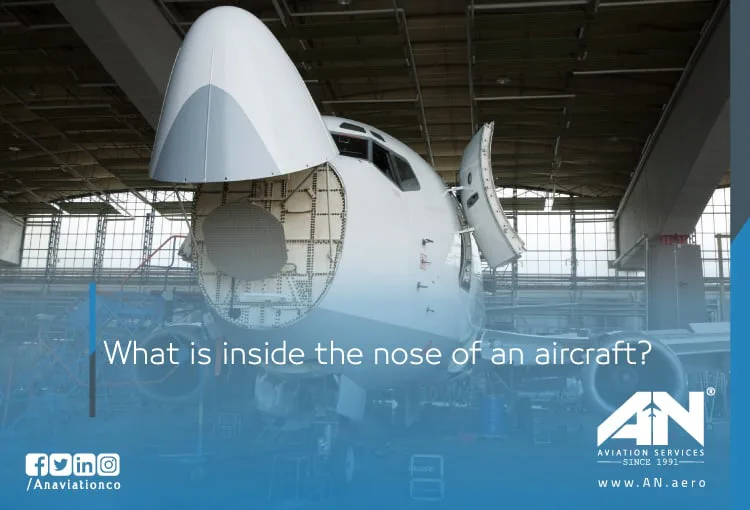
The nose of an aircraft, often referred to as the nose cone, is a vital yet often overlooked part of its structure. At first glance, the aircraft nose may appear to simply be an aerodynamic design feature that helps the plane slice through the air. But there’s far more going on inside than meets the eye. This carefully engineered section of the plane houses critical components that support navigation, safety, and efficiency, playing a significant role in the operation of commercial airplanes and other aircraft types.
In this article, we’ll explore the intricate world inside the nose cone of an aircraft, uncovering the technology and systems that are essential for modern aviation.
The Role of the Aircraft Nose in Aerodynamics
Before diving into the components inside the aircraft nose, it’s important to understand its role in aerodynamics. The nose cone is designed to reduce drag, allowing the plane to move efficiently through the air. Its shape minimizes air resistance, making it easier for the engines to maintain speed and conserve fuel. In commercial airplanes, this aerodynamic advantage is particularly crucial, as it directly impacts fuel efficiency and overall flight performance.
Beyond aerodynamics, the nose cone serves as the housing for various systems that are essential for the aircraft’s operation. Let’s take a closer look at what’s inside.
What’s Inside the Nose Cone?
Weather Radar Systems:
One of the most important components inside the aircraft nose is the weather radar. This system allows pilots to detect and navigate around severe weather conditions, ensuring a safer flight. Using radar signals, the system identifies precipitation levels, turbulence, and storm formations in real time. This information is displayed on the cockpit instruments, giving the flight crew the ability to adjust their route or altitude to avoid dangerous conditions.
Modern weather radar systems are highly sophisticated, capable of distinguishing between different types of precipitation, such as rain, hail, or snow. In addition, they can detect turbulence within storm clouds, helping pilots make informed decisions during flight. Without this technology, commercial airplanes would face significant risks when flying through unpredictable weather.
Avionics and Flight Navigation Systems
The nose cone also houses critical avionics systems that assist with navigation. These systems include antennas, sensors, and instruments that enable the aircraft to communicate with air traffic control, determine its position, and maintain a precise flight path. While much of the avionics equipment is located in other parts of the plane, the aircraft nose serves as an ideal location for certain sensors due to its unobstructed forward-facing position.
For example, navigation systems like the VOR (VHF Omnidirectional Range) and ILS (Instrument Landing System) use antennas located in or near the nose cone. These systems are vital for guiding the aircraft during landing approaches, especially in low-visibility conditions.
Pitot Tubes and Air Data Sensors
Positioned near or within the aircraft nose, pitot tubes are small but critical instruments that measure airspeed. They work by capturing the flow of air as the plane moves forward, providing real-time data about the plane’s speed relative to the surrounding air. This information is displayed on the cockpit’s airspeed indicator and is essential for safe flight operations.
In addition to pitot tubes, other air data sensors located in the nose cone measure altitude, air pressure, and temperature. Together, these instruments provide the flight crew with the information needed to maintain stable and efficient flight.
Electrical and Heating Systems
To ensure that systems like the weather radar and pitot tubes operate correctly, the aircraft nose is equipped with electrical and heating systems. For instance, heating elements prevent ice from forming on the nose cone and pitot tubes, which could interfere with the accuracy of the instruments. In cold weather or at high altitudes, these systems are essential for maintaining operational safety.
A Blend of Form and Function
The aircraft nose is a perfect example of how design and functionality come together in aviation. While it contributes to the sleek, aerodynamic profile of the plane, its primary purpose is to house and protect critical systems. These systems, from weather radar to navigation instruments, ensure that each flight is safe, efficient, and reliable.
How the Nose Differs in Military and Commercial Aircraft?
While the basic purpose of the nose cone is consistent across all types of aircraft, the specific components inside can vary depending on the plane’s mission. In commercial airplanes, the focus is on navigation, communication, and weather detection. In contrast, military aircraft may include advanced radar systems for tracking targets, as well as sensors for surveillance or reconnaissance missions.
For example, fighter jets often have a pointed nose cone equipped with radar systems capable of detecting other aircraft or ground targets at long distances. These systems are highly specialized and differ significantly from the weather radar used in commercial airplanes.
Why the Nose Cone Matters?
The nose cone may seem like a small part of the aircraft, but it plays a crucial role in every flight. By housing essential systems like weather radar, avionics, and air data sensors, it ensures that pilots have the information they need to navigate safely. Additionally, its aerodynamic design contributes to the efficiency of the aircraft, reducing drag and conserving fuel.
For passengers, the aircraft nose represents one of many behind-the-scenes innovations that make modern aviation safe and reliable. The next time you board a plane, you can appreciate the technology and engineering housed within the nose cone, quietly working to ensure a smooth journey.

